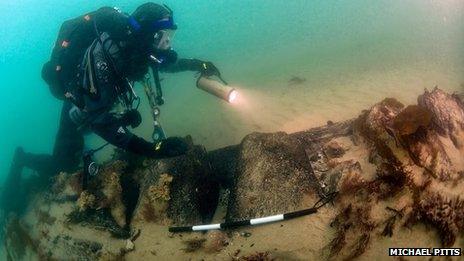HMS Invincible wreck 'at risk' English Heritage site
- Published

The site has been placed in the top 10 of the Heritage at Risk Register 2013
The wreck site of the Royal Navy's first HMS Invincible warship has been listed among the top 10 most at risk heritage sites in the country.
The designation of the protected site at Horse Tail Sand, in the Solent, near Portsmouth, has been made by English Heritage.
Also included are Sandycombe Lodge, in Richmond, London, and The Orangery at Blithfield Hall, Staffordshire.
HMS Invincible ran aground in 1798 after its rudder became jammed.
It was launched in 1744 as a third rate 74-gun French warship, but was captured by the British Navy at the first Battle of Finisterre in 1747.
'Vulnerable artefacts'
English Heritage described the wreck site as "unusual" and said it had been placed on the Heritage at Risk Register 2013 because archaeological monitoring had revealed significant parts of the site are becoming exposed due to lowering seabed levels.
Dan Pascoe, of Pascoe Archaeology Services, has been commissioned by English Heritage to record exposed areas and add them to the existing site plans before they deteriorate further.
The marine archaeologist said he had already discovered lids from gunpowder barrels and musket flints at the site of the wrecked 15m-long (50ft) ship.
"It's important that we record fragile and vulnerable artefacts of the ship when they become exposed so we can save it forever - preservation through record," he said.
In total seven Royal Navy warships have been named HMS Invincible - the last being the aircraft carrier which was scrapped in Turkey, in 2011.
The Heritage at risk register is an annual survey of Grade I and II* buildings, scheduled monuments, landscapes, battlefields, conservation areas and wreck sites.
- Published8 February 2011